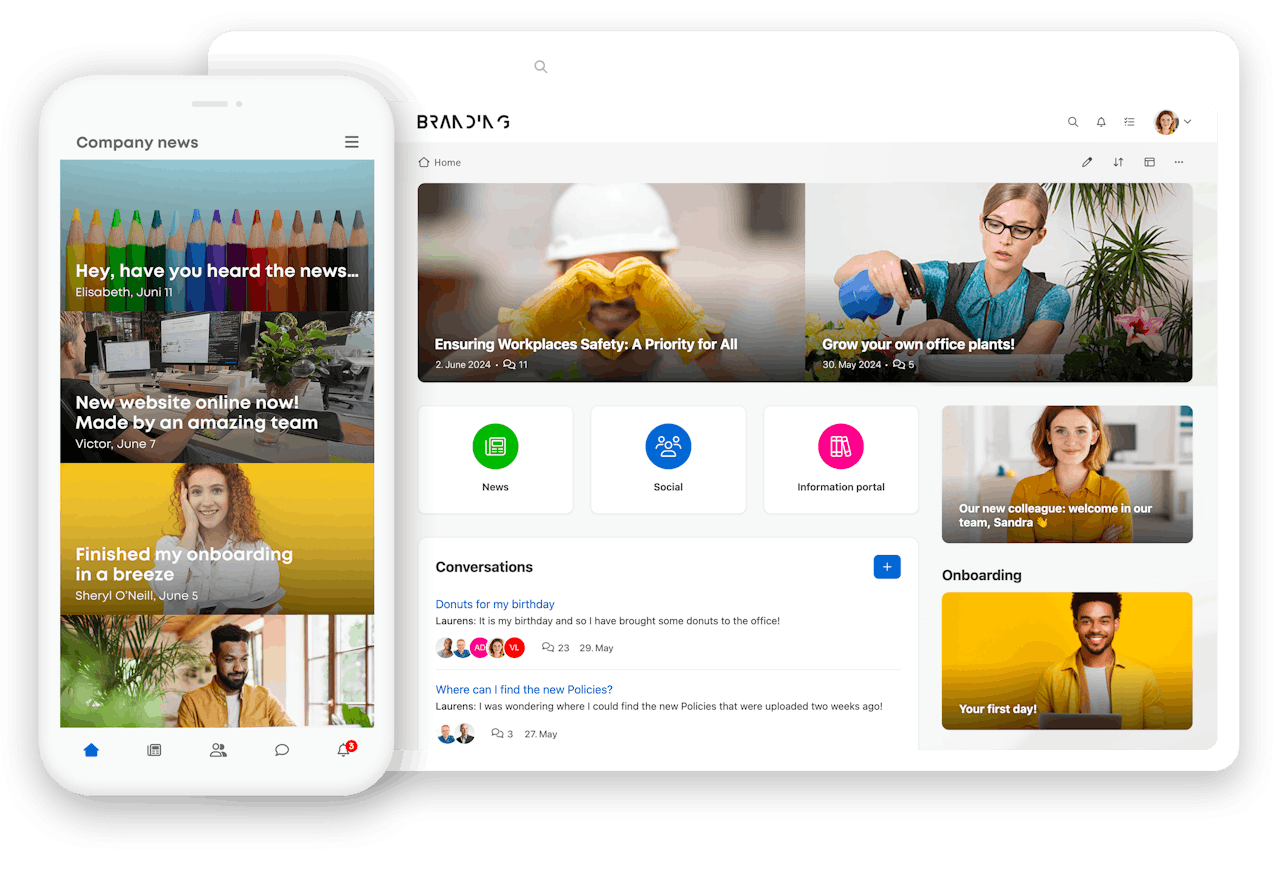The future of manufacturing: Engaging employees, connecting knowledge
Blog | Customer insights

In today’s manufacturing world, success depends on both skilled and engaged employees. However, the sector faces challenges like high turnover, rapid technological changes, and evolving regulations. How can you keep employees motivated and up-to-date? What if there was a solution that integrates communication, learning, and efficiency? In this blog, we’ll explore how manufacturers—from local suppliers to highly regulated aerospace sectors—can overcome these challenges with digital solutions, boosting employee engagement, improving knowledge transfer, and enhancing overall business performance.
1. High employee turnover and recruitment challenges: How to keep employees engaged?
Employee turnover and recruitment struggles are persistent challenges in manufacturing. Physical work is often undervalued, leading to difficulty retaining employees in repetitive, physically demanding roles. Employees may feel disconnected from the larger goals of the company, causing them to seek opportunities elsewhere.
In sectors like defense and aerospace, the need for highly skilled technicians and engineers is growing. This highlights the necessity of a workforce that is not only competent but also engaged in their crucial work. In these demanding environments, employee retention becomes a matter of operational integrity—and in some cases, national security.
The challenge: New employees need to acquire the necessary skills quickly, while experienced employees must keep up with evolving industry standards. A lack of engagement and career development opportunities can make retention difficult, especially if employees don’t feel recognized for their work.
Solution: Here’s where digital solutions come into play. KIOXIA, a leading tech company and a subsidiary of Toshiba, uses Fellow LMS to create a personalized and engaging learning environment for employees. This platform not only helps onboard new employees faster but also ensures they feel connected to the company’s culture and values. When employees feel they belong and can develop their skills at their own pace, they’re more likely to stay engaged and loyal.
Tip for manufacturers: Implement a flexible platform that supports self-paced learning and integrates your company values. Employees who feel personally connected to the company culture and have the opportunity to develop new skills are less likely to leave.
Read more about the KIOXIA case: Embracing the new CI with eLearning
2. Connecting employees across locations and departments
In manufacturing, teams often work in isolated environments—whether in different factories, along production lines, or at various geographical locations. This can lead to a sense of disconnect and a lack of collaboration between different departments or facilities.
The challenge: Employees can often feel isolated in their departments or locations, which leads to lower engagement, inefficiency, and missed opportunities for collaboration. The challenge lies in fostering communication between departments and ensuring that everyone feels part of the same team, even if they are not physically working together.
Solution: Coster Diamonds uses Fellow Intranet to create a centralized communication space where employees can share updates, collaborate, and stay informed. The platform allows employees from different cultural backgrounds and departments to communicate seamlessly, fostering a stronger sense of community and working toward a shared purpose.
Tip for manufacturers: Break down communication silos by implementing a user-friendly platform that makes it easy for employees from different locations to collaborate. An intranet-based system can help improve cross-departmental connections and make the entire workforce feel more engaged with the company’s broader goals.
“We had a huge email culture. Bad, inefficient! That’s 100% different now. With the daily notification emails from the Fellow Intranet, email traffic has decreased significantly. This brings peace of mind and ensures a more efficient way of working. Because the information on the Fellow Intranet is well-structured, a lot of time is saved by not having to search endlessly. The best ‘side benefit’ is that everyone knows what is going on. Now the diamond cutter also sees the ads from the marketing department showcasing his work. Nice, right?”
3. Skills gaps and continuous training: Keeping up with change
As technology evolves, manufacturing workers need to keep up with new machinery, tools, and processes, especially as automation and AI become more integrated into production lines. In addition to technical training, there’s a continual need for safety and compliance training to ensure workers understand and adhere to necessary regulations.
The challenge: Manufacturing employees need to gain new technical skills to operate advanced machinery and handle new technology, while also staying updated on safety protocols and regulatory requirements. Keeping track of both areas of development can be overwhelming, especially when resources are limited, and employees have tight schedules.
Solution: The Fellow LMS platform allows employees to access training on both technical skills and safety/compliance procedures at their own pace, ensuring that no one falls behind on essential knowledge. The platform’s flexibility means employees can balance their learning with daily work demands, while the reporting features ensure that management can track training progress and compliance.
Additionally, the app provides a central hub for relevant documents, safety protocols, and more. This makes it easier for employees to access up-to-date safety training and operational guidelines, ensuring everyone stays informed and compliant without disrupting their work.
Tip for manufacturers: Integrating all types of training—whether technical or safety/compliance-related—into a single, unified digital platform can help streamline learning processes. Using mobile-friendly solutions like the Fellow employee app allows employees to access crucial training materials anytime, anywhere, helping close the skills gap and ensure continuous compliance without disrupting work schedules.
“Recently, we conducted a survey for the HR department, and we also used the LMS for this purpose. The results could be downloaded as an Excel file with all relevant data for further processing. Just because it’s originally a Learning Management System doesn’t mean creativity has to stop there.”

4. Knowledge transfer and succession planning: Keeping expertise intact
A significant portion of the workforce in manufacturing is nearing retirement, while younger employees are entering the field without the same depth of institutional knowledge. This knowledge gap—especially in technical or machinery-related areas—can lead to inefficiencies and disruptions when experienced workers leave the organization.
The challenge: The challenge lies in ensuring that critical knowledge—whether it’s about production processes, machinery maintenance, or company-specific practices—doesn’t leave with experienced workers. Without a robust system in place for transferring knowledge, companies risk losing valuable insights and expertise, leading to delays, errors, or a drop in quality standards.
Solution: A centralized knowledge repository, where all critical procedures, workflows, best practices, and tips are stored, can be implemented and made easily accessible to all employees. Manufacturing companies can create and maintain this repository within an employee app or platform, regularly updating it with new insights, documents, and standard operating procedures (SOPs). By allowing employees to contribute their own videos, texts, and documents to this repository, companies can ensure a more holistic and sustainable knowledge transfer.
Tip for manufacturers: Invest in a digital platform that serves as a centralized hub for all knowledge—from technical procedures to company policies. A well-organized repository ensures that critical knowledge is easily accessible and continually updated. Encouraging knowledge sharing across departments helps make knowledge transfer a collaborative and ongoing process, which is essential for ensuring a seamless transition when senior employees leave.
Coster Diamond's intranet solution: Becoming the linchpin in a changing corporate culture
Conclusion: The future of knowledge management in manufacturing
Digital solutions like Fellow LMS and Fellow Intranet provide manufacturing companies with a powerful way to tackle challenges in employee engagement, training, and knowledge management. By combining these tools—especially in the unique way Fellow Digitals offers—manufacturers can boost employee retention, streamline knowledge transfer, and ensure compliance, all while building a more engaged, skilled workforce.
Interested in optimizing knowledge sharing and employee development in your manufacturing company? Get in touch with us today!
We love to share our knowledge with you
Related blogs



